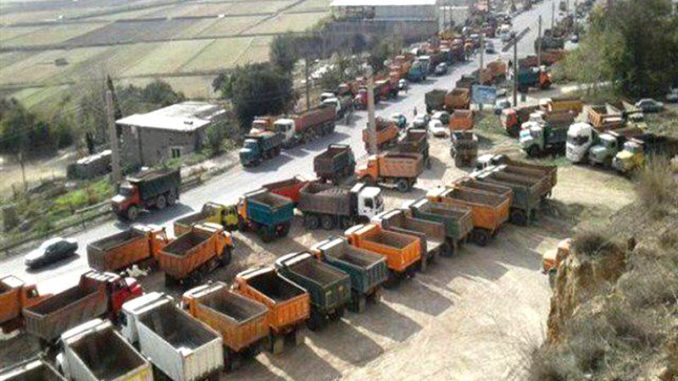
Truck drivers in Iran continued their widespread strike on Friday for the fifth consecutive day in at least 85 cities in 25 provinces across the country including Tehran, Mashhad, Isfahan, Shiraz, Kermanshah, Kerman, Zanjan, Urmia, Abadan, Ahwaz, Karaj, Arak, Shahrood, Qazvin, Hamedan, Malayer, Khorramabad, Naghadeh, Najaf Abad , Mobarakeh, Bandar Abbas, Saveh, Khaf, Semnan, Shahrood, Shahrekord, Farrokhshahr, Zahedan, Bojnourd; Yazd; Bandar Khomeini; Khormoussa; Chazabeh; Jajarm; Garmeh; Sabzevar; Shirvan; Kangavar; Darab; Marvdasht; Jahrom; Zarghan; Faroogh; Chalus; Asadabad; Tuyserkan; Andimeshk; Bandar-Mahshahr; and Qom.
The Iranian regime has resorted to various tricks to break the strike in recent days. In Mashhad, the regime’s authorities sold cheap tires at the terminal and advertised it in a bid to deceive the drivers and break their strike. However, the Mashhad terminal was empty and no truck showed up for loading.
In Sarbandar (Khuzestan province), the regime officials used the trucks belonging to Ministry of Transportation for loading goods to confront the strikers. In Shahrekord, the regime tried to thwart the strike of truck drivers by using trucks associated with government bodies.
In Kermanshah, intelligence agents and the police tried to force the drivers to break their strike by removing the license plates of the trucks of strikers, but they were faced with the protest of strikers’ families.
In Bandar Abbas, the regime mobilized a number of moles among the drivers to start loading goods, and desperately tried to show the situation as normal.
However, the regime’s attempt to stop the strike of truck drivers has been futile. As the drivers resumed their strike, the head of the regime’s transportation union, Mohammad Khanbalooki, claimed that more than 70 percent of truck drivers’ demands had been met and their major problems had been resolved. He said that all the drivers are aware and know that they should not allow their demands to be used as a means by the enemies of the country…most of those who turned the truck drivers’ gathering into turmoil were from the PMOI who had infiltrated among the drivers…. and all truck drivers have been informed of the PMOI’s attempt for misusing this atmosphere…the routes for the truck drivers in country’s roads are open and 90% of truck drivers have received their bill of loading (state-run websites – July 23).
However, in an interview with state-run ILNA news agency on Wednesday July 25, 2018, chairman of Iran Truck Drivers Association, Ahmad Karimi, accused Iran’s Industry Ministry of not fulfilling its obligations, saying “most dissatisfaction are due to the Ministry of Industry, Mining and Trade’s performance, as the ministry has failed to fulfill its commitments.”
Increased truck tires and parts prices are among the major concerns of striking truckers who demand being provided with truck tires at subsidized prices. Increased highway tolls, truck parts prices, insurance premiums, and truck maintenance costs are some of the reasons behind truck drivers’ protests.
The National Council of Resistance of Iran (NCRI) has released some video footage of the strike in various cities and issued a statement on July 25 saluting the striking truckers and calling on brave Iranian youths across the country to support them and show their solidarity. The NCRI also urged the International Labor Organization and other relevant international bodies and trade unions as well as syndicates of truck drivers in different countries to support the goals of the striking drivers in Iran.

